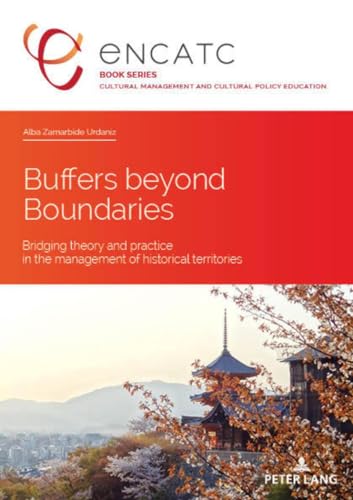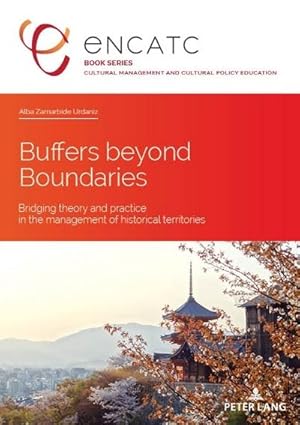Zamarbide Urdaniz Alba (6 results)
Product Type
- All Product Types
- Books (6)
- Magazines & Periodicals
- Comics
- Sheet Music
- Art, Prints & Posters
- Photographs
- Maps
- Manuscripts & Paper Collectibles
Condition
Binding
- All Bindings
- Hardcover
- Softcover (6)
Collectible Attributes
- First Edition
- Signed
- Dust Jacket
- Seller-Supplied Images (4)
- Not Print on Demand (4)
Free Shipping
- Free US Shipping
Seller Location
Seller Rating
-
Buffers beyond Boundaries : Bridging theory and practice in the management of historical territories. ENCATC book series cultural management and cultural policy education ; Vol. 6
Published by Bruxelles ; Bern ; Berlin ; Wien : P.I.E. Peter Lang, 2019
ISBN 10: 2807612717ISBN 13: 9782807612716
Seller: Fundus-Online GbR Borkert Schwarz Zerfaß, Berlin, Germany
Book
Broschur. Condition: Wie neu. 267 Seiten : Illustrationen ; 21 cm, 357 g Tadelloses, sauberes Exemplar. What is a buffer? Is it a control zone? Or is it rather a transition space, a blurred boundary? Since "buffer zones" were introduced in the late 1970s as a complementary protection layer to World Heritage sites, the dimensions of heritage have changed significantly; from physical to intangible, from defined to diffused. Now, buffers can present all these different characters, even at the same time. Using buffers as the main connection thread, this book is a collection of complementary studies that explore the contemporary challenges in heritage definition and management. With a focus on European and Asian historical territories, this book tracks umbrella terms, from their genesis inside international discussions and cultural exchanges, to their specific interpretation in top-down on-site strategies. Then, it originally complements and verifies these official management models with the study of local realities and parallel bottom-up actions that have emerged to fill major gaps in this system. With this, the book underlines the negative impacts of isolated biased strategies, and addresses the call of local intermediate groups and communities for integrated efforts. Finally, buffers are presented as an intermediate heritage management model that could help integrate both, protection and development, territorial and community scales. Table of contents Introduction 11 Chapter Is Buffer problems 20 1.1 Chapter introduction: Why do buffers matter? 20 1.2 Contemporary problems of buffers 22 1.2.1 Problem of "heritage" theoretical definition 22 1.2.2 Problem of "buffer" theoretical definition 25 1.2.3 Problem of physical definition 27 1.2.4 Problem of practical and legal significance 31 1.2.5 Problem of heritage governance and awareness 37 Chapter 2: Study nl. Cultural implications of buffers 40 2.1 Chapter introduction: Do Eastern and Western ideascollide? 40 2.2 Cultural dimensions of heritage and space 41 2.2.1 The monument and the origins of heritage boundaries 42 2.2.2 Cultural notions of space 43 2.2.3 The nature-culture divide 48 2.2.4 The cultural implications reflected in heritagemanagement in Eastern countries 49 2.3 Exchanges East-West in the UNESCO context 52 2.3.1 Evolution until 1995 53 2.3.2 Evolution until 2010s 56 2.3.3 Recent approaches 62 Chapter 3s Study n2. Conceptual roles of buffers 68 3.1 Chapter introduction: Is there only one valid definition of"buffer"? 68 3.2 Conflicts in world heritage "buffer" definition 70 3.3 Different buffer characteristics and dimensions 77 3.3.1 Theoretical types by analysis of " World Heritageand Buffer Zones' 77 3.4 Complementary simultaneous buffers 89 3.4.1 The natures of the different buffer types 89 3.4.2 Simultaneity of buffer types 89 3.5 Expanding or restricting the notion of buffer: the dilemma 91 3.5.1 The "buffer" in the HUL approach 91 Chapter 4s Study n3. The morphology of buffers 94 4.1 Chapter introduction: What shapes do heritage zonespresent? 94 4.2 The shapes of heritage zones 99 4.2.1 Physical elements defined by heritage zones 99 4.2.2 Defining just one heritage site 102 4.2.2.1 Boundary basic types 102 4.2.2.2 World Heritage area definition strategies 112 4.2.3 Defining sites composed by multiple heritage areas 113 4.2.4 Section conclusion 115 4.3 The evolution of heritage boundaries 119 4.4 The simplification of heritage physical identification 122 Chapter 5: Study n4. Buffers in practice 124 5.1 Chapter introduction: How do buffers connect to on-sitemanagement tools? 124 5.2 The management of the historical territory 129 5.2.1. Case A. Aranjuez, reliance on municipal boundaries 129 5.2.2. Case B. Ferrara, a city and a natural park connected by the rural 136 5.2.3. Case C. Val d'Orcia, a shared territory 143 5.2.4 Case D. Thua Thien Hue, monuments over landscapes 150 5.2.5 Case E. Angkor, an archaeological park isolatedfrom its regional context 159 5.2.6 Case F. Bali, enclosed sacred agricultural landscapes 170 5.3 Extensive weak areas or narrow control zones 175 5.4 Disconnection of heritage zones, strategies and tools 176 Chapter 6: Buffers vs. heritage management boundaries 178 6.1 A critique of the actual use of "buffers" 178 6.2 Theory vs. practice: The dominance of static restrictivezoning 180 Chapter 7: Study n5. Buffers and intermediate group 183 7.1 Chapter introduction: Multi-layered regions, multiplestakeholder scenarios? 183 7.2. "Ferrara, city of renaissance, and its Po delta" 185 7.2.1 The evolution of the WH site and its partiallegislation 185 7.2.2 Strategies and projects developed with or byintermediate actors in Ferrara 188 7.2.2.1 A creative historical city 188 7.2.2.2 The interpretation of the territory 191 7.2.23 Awareness raising 195 7.2.3 Evaluation and future for Ferrara, towards a sharedterritorial strategy 197 7.2.4 Reassessment on common reflections for Ferrara 199 7.3. "Complex of Hue monuments" 200 7.3.1 Static protection of monumental heritage 200 7.3.2 Evolution of parallel strategies 200 7.3.3 Evaluation and future for H ue 204 7.3.4 Reassessment on common reflections for Hue 206 7.4. Pending points 208 Chapter 8: Study n6. Buffers and communities 211 8.1 Chapter introduction: What is the impact of narrowbuffers on local communities? 211 8.2 The historical ecosystem of the Nguyen Royal Tombs 213 8.2.1 The historical structure of the Nguyen Royal Tombs 217 8.2.2 Tomb protection and management 217 8.2.3 The role of local communities 218 8.2.4 The villages surrounding the Nguyen Royal Tombs 218 8.2.5 The study of culture-nature links 219 8.3 Visualizing tomb-village ecological and cultural links 220 8.3.1 Characterization of the environment of each tomband neighbouring villages 220 8.3.2 Comparative analysis 232 8.3.2.1 Tomb-village symbiosis before World Heritage registration 232 8.3.2.2 Present tomb-village ecosystems 235 8.3.3 Partial conclusions 239 8.4 "Living buffers", linking heritage protection and traditional liv.
-
Buffers beyond Boundaries: Bridging theory and practice in the management of historical Territories
Published by Peter Lang, Bruxelles, 2019
ISBN 10: 2807612717ISBN 13: 9782807612716
Seller: PsychoBabel & Skoob Books, Didcot, Oxfordshire, OXON, United Kingdom
Book
Paperback. Condition: New. Paperback in like new condition. New shopstock with minor shelf-wear, no faults. TA. Used.
-
Buffers beyond Boundaries
Published by Peter Lang Sep 2019, 2019
ISBN 10: 2807612717ISBN 13: 9782807612716
Seller: BuchWeltWeit Ludwig Meier e.K., Bergisch Gladbach, Germany
Book Print on Demand
Taschenbuch. Condition: Neu. This item is printed on demand - it takes 3-4 days longer - Neuware -What is a buffer Is it a control zone Or is it rather a transition space, a blurred boundary Since 'buffer zones' were introduced in the late 1970s as a complementary protection layer to World Heritage sites, the dimensions of heritage have changed significantly; from physical to intangible, from defined to diffused. Now, buffers can present all these different characters, even at the same time.Using buffers as the main connection thread, this book is a collection of complementary studies that explore the contemporary challenges in heritage definition and management. With a focus on European and Asian historical territories, this book tracks umbrella terms, from their genesis inside international discussions and cultural exchanges, to their specific interpretation in top-down on-site strategies. Then, it originally complements and verifies these official management models with the study of local realities and parallel bottom-up actions that have emerged to fill major gaps in this system. With this, the book underlines the negative impacts of isolated biased strategies, and addresses the call of local intermediate groups and communities for integrated efforts. Finally, buffers are presented as an intermediate heritage management model that could help integrate both, protection and development, territorial and community scales. 272 pp. Englisch.
-
Buffers beyond Boundaries : Bridging theory and practice in the management of historical territories
Published by Peter Lang, 2019
ISBN 10: 2807612717ISBN 13: 9782807612716
Seller: AHA-BUCH GmbH, Einbeck, Germany
Book
Taschenbuch. Condition: Neu. Druck auf Anfrage Neuware - Printed after ordering - What is a buffer Is it a control zone Or is it rather a transition space, a blurred boundary Since 'buffer zones' were introduced in the late 1970s as a complementary protection layer to World Heritage sites, the dimensions of heritage have changed significantly; from physical to intangible, from defined to diffused. Now, buffers can present all these different characters, even at the same time.Using buffers as the main connection thread, this book is a collection of complementary studies that explore the contemporary challenges in heritage definition and management. With a focus on European and Asian historical territories, this book tracks umbrella terms, from their genesis inside international discussions and cultural exchanges, to their specific interpretation in top-down on-site strategies. Then, it originally complements and verifies these official management models with the study of local realities and parallel bottom-up actions that have emerged to fill major gaps in this system. With this, the book underlines the negative impacts of isolated biased strategies, and addresses the call of local intermediate groups and communities for integrated efforts. Finally, buffers are presented as an intermediate heritage management model that could help integrate both, protection and development, territorial and community scales.
-
Buffers Beyond Boundaries: Bridging Theory and Practice in the Management of Historical Territories
Published by Peter Lang Pub Inc, 2019
ISBN 10: 2807612717ISBN 13: 9782807612716
Seller: Revaluation Books, Exeter, United Kingdom
Book
Paperback. Condition: Brand New. 267 pages. 8.50x6.00x0.75 inches. In Stock.
-
Buffers beyond Boundaries
Published by Peter Lang Ltd. International Academic Publishers, 2019
ISBN 10: 2807612717ISBN 13: 9782807612716
Seller: moluna, Greven, Germany
Book Print on Demand
Condition: New. Dieser Artikel ist ein Print on Demand Artikel und wird nach Ihrer Bestellung fuer Sie gedruckt. Using buffers as the main connection thread, this book is a collection of complementary studies that explore the contemporary challenges in heritage definition and management. With a focus on European and Asian sites, the research presents different cont.






